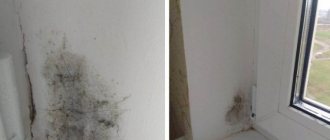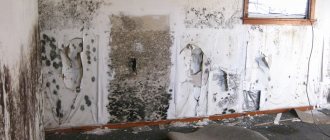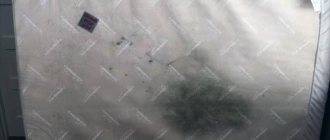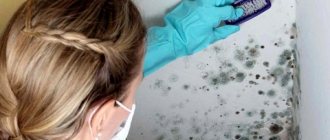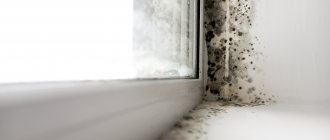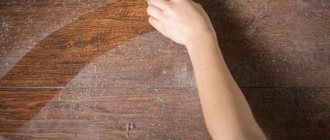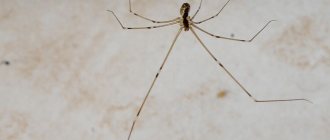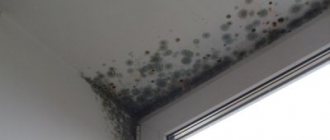The appearance of a black coating indicates that mold, dangerous to humans, has settled in the apartment or house. This fungus is difficult to remove on your own, so it is important to begin treatment when the first signs of infection appear. However, the destruction of microorganisms is not enough - it is worth taking preventive measures to prevent a re-attack of harmful spores.
Types of black mold
Mycelium looks like fluffy growths or stains of a black hue
. What is popularly called black mold combines different types of microscopic fungi. They feed on dead organic matter, reproduce by spores, and settle on personal hygiene items, food, and furniture. Outwardly they look like stains or spots of dark shades (black, gray, greenish), upon closer examination they resemble cotton wool or velvety fabric. Pathogenic microorganisms multiply at an incredible rate, making it impossible to control their growth. The growth of black mold is caused by about three hundred strains of fungi, which are divided according to the degree of health hazard.
Aspergillus niger is a strain of fungus that appears more often than others in residential areas
Table 1. Strains of fungi that cause black mold growth.
| Fungus strain | Characteristics |
| Aspergillus niger | Saprophytes, which are common in places with high humidity. In apartments they grow on the surfaces of bathrooms, kitchens, damp book spines, washing machines, and air conditioners. Has an increased health hazard |
| Alternaria tenuis | The color of the mycelium depends on the growth conditions. Pathogenic microorganisms “love” overripe or rotten fruits, but they are also found on wooden surfaces. Causes serious harm to the human body |
| Aspergillus fumigates | Fungi attack damaged fruits and vegetables, but under favorable conditions they live on suitable residential surfaces. They do not pose a serious danger to a healthy person, but are harmful to children, allergy sufferers, and people with reduced immunity. |
| Penicillium | The spores are used in the manufacture of medicines and elite varieties of cheese. Fungi often live near humans and are practically harmless, but some strains belong to risk groups 3 and 4 |
| Cladosporium | Found in open areas and in buildings, some species feed on fuels, lubricants or other chemicals |
| Chaetomium | It occurs infrequently in residential areas, but poses a fatal danger if it enters the digestive tract - there are cases of death known to medicine |
Attention! It is impossible to distinguish safe fungi from pathogenic ones by appearance, so dark stains on surfaces must be dealt with in any case.
Two sides of the same green coin
Be it Alexander Fleming with his incredible bow tie and blue eyes, who made two of the most important discoveries for humanity due to his own negligence and sloppiness: first by sneezing into a Petri dish with bacteria, introducing snot into laboratory material and thus discovering lysozyme in 1922, and then , allowing dust and spores to enter the culture of staphylococcus he was studying, grew Penicillium rubens in 1929, inadvertently discovering the properties of penicillin. Or whether it was the Hospital Brotherhood of St. Anthony, which in the Middle Ages treated gangrenous lesions due to poisoning with sclerotia (the wintering form of the ergot species Claviceps purpurea) - ergotism or “St. Anthony’s fire.” In one case, mold saved millions of lives from painful death due to gangrene, sepsis and infections, in another it itself caused epidemics with tens of thousands of victims slowly rotting alive with the same gangrene and sepsis, going crazy from toxins, on the basis of which later, by the way , made LSD.
On the left is Alexander Fleming, on the right is the consequences of eating ergot, painting by Matthius Grünwald.
The evolutionary irony lies in the sheer ambiguity of mold. No matter what fluffy and slimy place in its taxonomy we poke the curious finger of a scientist, there are a million little “buts” everywhere. Almost always, as dangerous as it is, it is exactly as necessary. But what ScientaeVulgaris knows for sure is that fuzzy mushrooms of any kind can cause you problems.
At the height of the French Revolution of 1789, a young, handsome 22-year-old soldier begins to complain of severe facial pain in the cheekbone area. The initial examination showed the integrity of the teeth, and the guy was not allowed to cut them. Then exophthalmos was added to the facial pain: the right eye suddenly popped out of its socket. He was immediately sent to the hospital. Once in the field surgery department of those years, Jacques Thibault began to fear for his life. An operation was scheduled. His alveolar process was perforated. Based on the results of the operation, a fungal porous mass was discovered in the maxillary sinus. The doctor completely refused to cut it out due to severe bleeding and the inability to continue the operation due to its complexity. The guy was sewn back together with the mushroom and sent back from where he came.
18th century eye surgery manual and instrument set:
After 22 days, the strange tumor grew a little more, filling part of his mouth and the entire right nostril, beginning to cause difficulty swallowing and breathing. He is sent again to the hospital in Paris, where surgeons still remove and clean the mycelium. To prevent further growth, white cauterization is used.
Then there were three types: black, red and white. I’m telling you so that you understand the essence of the entire medical process. The names are given based on the glow colors of the metal tool. Chronic diseases of bones and joints were cauterized for blacks, and nerves (hysterical states) were treated. Red according to the instructions, light bleeding from the bone or hole after tooth extraction. Bright red for the treatment of fistulas, ulcers and purulent wounds. Jacques was prescribed white cauterization (by the way, they also treated prostatitis by inserting a white-hot needle into the prostate). Cauterizing the fungus helped Jacques for a while. But after a couple of weeks, new growths appeared on the back of the palate again. They were cauterized in the same way, the patient was observed and, since nothing else grew from him, they were discharged after 134 days. The further fate of the French soldier and his appearance after the operations are unknown. But de facto, he was the first recorded patient with a terrible problem caused by the fact that fungi of the genus Aspergillus fumigatus tried to eat him alive.
A hundred years before these events, back in 1729, the Italian priest and biologist Pier Antonio Micheli, while cataloging mold, noticed their curious similarity with aspergillus (Aspergillum, from Latin spargere - to spray) or, in Russian, with church sprinkling. And then in 1863, the Frenchman Georg W. Fresenius, while researching pulmonary lesions, divided the Aspergillus genus of molds into species, isolating from it fumigatus (from the Latin fumeus - smoky). Such a smoky sprinkle. Fumigatus is incredibly widespread in nature, its spores measuring only 2-3 microns are carried with every breath of fresh wind in every minute of the existence of life on earth for many millions of years.
Church sprinkling and mold of the same name:
By his calling, he is a saprotroph, like most other representatives of mold (saprós - “rotten” and trophē - “nutrition”), and professionally breaks down complex biological compounds of cells into simple ones, returning all kinds of organic carrion to the bosom of Mother Nature. Most of it can be found in compost, where there is an active process of decay of organic matter. The fungus can form two types of colonies: fluffy and velvety. Very tenacious and survives up to 70 degrees Celsius. Every day we inhale hundreds of its spores. But our immune system copes and successfully neutralizes the invading fungal pathogens. Then why did Jacques get sick?
Causes of mold
Condensation on metal-plastic structures is a factor causing the appearance of fungus
Prices for ventilation valves for metal-plastic windows
Ventilation supply valve for metal-plastic windows
Black mold easily penetrates the home, but under unfavorable conditions it dies. The reasons for the proliferation of the fungus are high temperature and humidity, which are the result of errors made during the construction of buildings, the use of synthetic materials in the decoration of premises, and non-compliance with sanitary standards.
- Metal-plastic structures. Windows made of metal-plastic are a comfortable solution for residential premises. They are comfortable, protect from noise and cold, and do not require significant installation costs. But if used incorrectly, metal-plastic structures can cause the growth of black mold. The windows are closed hermetically, which disrupts air circulation and prevents the rooms from being ventilated. In addition, if installed incorrectly, condensation will form on the structures, increasing the humidity levels in the room.
- Drywall. The building material used in the construction and decoration of buildings adversely affects the microclimate. The disadvantage of drywall is its ability to absorb moisture, which causes the room to become damp, which increases the likelihood of the growth of pathogenic microorganisms.
- Poor ventilation. Ventilation systems are often designed in violation of building codes, and older structures become clogged and fail. In bathrooms, bathrooms and kitchens, natural ventilation does not always cope with high air humidity, which creates favorable conditions for uninvited guests.
- Building defects. Miscalculations by designers and errors in the construction of residential buildings lead to the fact that during rainfall the walls get wet and moisture accumulates in the basements. A similar problem arises when there are no drainpipes or waterproofing at the joints of the panels. Fungal spores grow through cracks in building materials and then end up in residential areas.
- Failure to comply with sanitary standards. Microorganisms that cause the growth of black mold often enter the home along with spoiled fruit or moldy bread. If such a product sits in the kitchen for a long time, the spores will spread to surfaces that are suitable for their growth.
Bath, toilet, kitchen - favorite places for black mold
Favorite places for mold growth are the bathroom, toilet, kitchen, but if conditions are favorable, they also appear in other rooms.
For reference! Conditions favorable for the development of fungi are temperature 18-25 degrees, humidity from 70%. To prevent the growth of pathogenic microorganisms, these parameters must be monitored regularly.
Where does it get into the house from?
Such mold can enter a house or apartment through open windows, balconies, blown in by the wind, or perhaps through ventilation openings. Frozen mold cells seem to be just waiting for an optimal habitat for them to appear in the bathroom or kitchen, or somewhere else - high humidity and a temperature of at least 10-12 degrees Celsius. She really loves musty rooms where there is no frequent airing or good ventilation.
Therefore, it is extremely important to regularly ventilate your home or repair the ventilation shafts. Where condensation accumulates, mold often forms as well.
Therefore, the pipes of all communications in an apartment or house need to be properly insulated. Or insulate the walls themselves outside the house.
Why is black mold dangerous?
Aspergillosis is a dangerous disease caused by a fungal infection.
Microscopic spores and particles of black mold do not remain in place, but fly with air currents throughout the rooms, penetrating the respiratory organs of people, settling on products and personal hygiene items. After penetration into the body, they become fixed in the tissues and begin to multiply intensively, causing serious diseases:
- rhinitis, sinusitis;
- meningitis;
- myocarditis;
- aspergillosis;
- bronchial asthma or pneumonia;
- conjunctivitis;
- papillomas, dermatological diseases.
Scientists have proven that the constant presence of fungal spores in the body increases the risk of cancer, and the toxins they release during their life processes cause intoxication and non-critical changes.
Allergic manifestations are one of the signs of fungal diseases
It is quite difficult to recognize diseases caused by black mold particles. Their symptoms do not differ from those of respiratory, dermatological and other ailments. You can suspect exposure to fungi if the disease is difficult to treat, but the patient feels better away from home. The second symptom is persistent allergies that are not related to the seasons, food intake or other allergens.
If pathological processes provoked by black mold occur, you should immediately consult a doctor - they can cause serious complications, and in severe cases, death.
Important! Fungi pose a particular danger to children - the appearance of dark stains on the walls of a nursery is a serious cause for concern for parents. Constantly inhaling pathogens can lead to serious health problems that can last a lifetime.
Video – How black mold kills us
Fungus damage
There are about one hundred thousand types of mold in total. Only a few are considered beneficial to the environment, while the rest cause great damage to humanity. Let's find out why the mushroom is dangerous. It chooses warm places with high levels of humidity as its habitat, which is why mold often appears in houses and apartments. It mainly occurs in corner, unventilated or unheated rooms.
The harm of mold to a person is difficult to overestimate, even if he does not have direct contact with it. The fungus releases toxic substances directly into the air. So they settle on the skin, causing rashes and itching, and also enter the human body through the respiratory tract, affecting vital organs. Dampness has a negative impact on health, and when interacting with fungal bacteria, it can cause the appearance of neoplasms, including malignant ones.
Mold in the home poses a particular danger to children; their bodies are in the developmental stage and are not resistant to the effects of toxins. Exposure to fungus in children can cause pathological processes that will accompany them into adulthood.
If a child is in constant contact with mold, he can become ill for life
How to deal with black mold
Fighting black mold is a long, difficult process that requires persistence.
To destroy fungal spores, special preparations or folk remedies are used. The process of dealing with an unwanted neighbor can be lengthy, but you should not retreat, otherwise the mold will grow, spread over surfaces and eat deep into materials.
Chemicals
Chemicals for black mold contain fungicidal and antiseptic components
Mold control products contain antifungal and antiseptic components. They destroy spores and prevent their appearance, which ensures the prevention of biological formations. The product is selected depending on the material of the surface to be treated, the size of the affected area, and the strain of the fungus.
A product with mold on it is dangerous to eat.
Table 2. Chemicals for black mold.
| Name | Application |
| Dali | A universal preparation used for common building materials, including concrete, brick, wood. It is allowed to apply the solution to finished surfaces (varnished or painted), tiles, and ceramics. Destroys all types of fungi, mold, algae, mosses |
| Fongifluid Alpa | A potent fungicide used to destroy biological formations. Before use, rough or porous surfaces are sanded, leveled, and then the product is applied. The procedure is carried out at a temperature not lower than 5 degrees, to consolidate the effect it is repeated 1-2 times |
| Olympus Stop mold | The product does not contain toxic compounds, chlorine or other dangerous components. It is used for all surfaces: brick, plasterboard, ceramics, wood, etc. The only drawback is the long exposure time (to achieve the effect, the solution is applied to the material for 2-3 days) |
| Biotol-Spray | The solution is sold in a convenient spray form, so there are no difficulties with application. Before use, the surface is carefully cleaned, treated with the preparation and left for the required time. |
| Mavix-bio+organosilicon water repellent VVM-7 AS | Two products that are used in combination. The first stage is the treatment of the walls with the impregnation included in the kit, after which Mavix-bio is applied, allowed to stand, the mold is cleaned from the surface, and the last step is the use of a hybrophobic agent, which protects against dust and moisture and ensures normal air exchange |
When using chemical antifungal agents, it is recommended to observe personal protective measures. It is necessary to work with gloves, a respirator, and goggles so that caustic drugs do not harm your health.
Personal protective equipment is used when treating contaminated surfaces
Surfaces are treated carefully, preferably with a soft brush or cloth, so that fungal spores do not scatter throughout the room. While the product is working, you need to ensure normal ventilation in the room - open the door, windows, or turn on the hood. All small items must be taken out and the rest covered with film. If the spores have penetrated too deeply, you will have to remove the top layer of material or coating and then carry out the treatment.
Attention! Do not use household bleach to combat mold. It is not able to solve the problem forever and emits harmful fumes that aggravate health problems.
Prices for different types of mold protection Pufas
Pufas mold protection
Folk remedies
Vinegar contains acids that destroy fungal spores
Many folk remedies contain components that help fight mold. They are not as effective as chemical drugs, but they are safer and inexpensive.
- Vinegar. To combat black mold, acid is poured into a container with a spray bottle, sprayed onto the infected surface, left for an hour and washed off with water. The procedure must be carried out for at least 2-3 days in a row, preferably a week.
- Hydrogen peroxide. The solution does not contain toxic components and has no pungent odor. The place where mold grows is treated with peroxide, left for 1-2 hours and the surface is washed.
- Ammonia. Alcohol works best on smooth surfaces, but gives poor results on porous materials. Combine the substance with water in equal proportions, apply, rinse off after a few hours.
- Baking soda. Dissolve a tablespoon of baking soda in a glass of water, treat the moldy area, leave, and then rinse lightly with water. It is recommended to leave a small amount of solution on the surface so that it protects against secondary growth of the fungus.
- Copper sulfate. For antifungal surface treatment, a solution of copper sulfate and water in a 1 to 1 ratio is used.
Peroxide is a safe and effective antiseptic
Traditional recipes are considered safe for health, but when using it, it is still recommended to use gloves with a respirator. For greater effectiveness, the products are mixed with each other, but in this case they can release toxic fumes.
Important! Some products (hydrogen peroxide, chemicals) change the color of the material's finish, so they should be used with caution on painted surfaces.
Fungicidal preparations
In advanced cases, when mold has affected a large surface or its spores have penetrated deep into materials, you will have to seek help from special fungicidal preparations produced by the chemical industry. These are various antifungal agents designed to destroy the fungus or prevent its occurrence. Their range is wide, and you can purchase products of this kind at any hardware or hardware store.
Before purchasing fungicidal compounds, you must carefully read the instructions so as not to make a mistake in your choice, since they differ in purpose, method of application and type of surfaces to be treated. For example, the QUELYD Anti-Mold product is available in two versions: for removing mold in living rooms and bedrooms or in bathrooms and toilets. Both drugs are suitable for sanitation and repair.
Biodom, SANATEX, PROSEPT FUNGI STOP will help as an emergency aid. They successfully fight various types of mold, moss and lichen and can be used on almost all building materials: concrete, brick, wood, slate, plaster, granite, tiles and even wallpaper.
How to get rid of black mold forever
Under favorable conditions, black mold can reappear
Step-by-step instructions - mold removal
To completely destroy mold, the use of special means is not enough - measures are needed to combat pathogens and create unfavorable conditions for their reproduction.
| Step, no. | Description | Photo |
| Step 1 | Check the hood and ventilation. To do this, use paper or a match - if, when brought to the grille, they are attracted to the ventilation hole, the system works normally. If there are any violations, it must be cleaned or forced ventilation installed. |
|
| Step 2 | Check windows and doors. Metal-plastic structures must be installed correctly; it is advisable to have an inlet valve to ensure normal air circulation |
|
| Step 3 | Inspect the doors. Doors with seals protect against noise and cold, but prevent normal ventilation. To eliminate the shortcoming, make holes at the bottom of the door or increase the space between the frame and the leaf |
|
| Step 4 | Remove the fungus. Clean the infected surfaces from mold, then treat them with a chemical or folk remedy, wait for the time specified in the instructions, rinse |
|
Prices for mold protection spray Mellerud
Mellerud anti-mold spray
If you limit yourself to cleaning contaminated areas from fungal spores, mold will reappear over time.
In severe cases, major repairs will be required to remove mold.
Attention! If the premises are in disrepair and fungal control measures do not produce results, it is better to turn to experts or make a major overhaul. It is strictly not recommended to stay in a room where pathogenic microorganisms live for a long time.
Video - Getting rid of black mold in the bathroom
When you need specialist help
In most cases, the use of folk recipes and household chemicals does not bring results. Only the visible part of the plaque is removed, the mycelium remains deep inside, so after some time, colonies of the fungus reappear in the room. Mold can be removed forever only with the help of specialists. Stages of fungus removal by professionals:
- assessment of area and degree of penetration;
- evacuation of fabric products and other undamaged items from the premises;
- destruction of all visible areas with fungus, including plaster;
- Microwave processing;
- application of fungicides;
- disinfection.
It is very difficult to defeat black mold, but it is possible. It is important to provide indoor conditions that prevent the appearance and proliferation of fungus. If mold does appear, it is necessary to remove it as quickly as possible using professional or improvised means.
5/5 — (1 vote)
Prevention of black mold
Myceliums are found behind the rubber seal of the washing machine
To prevent mycelium from appearing in your home, you need to follow simple sanitary and hygienic rules.
- Regularly check the ventilation, clean the duct of dirt, debris, dust, ventilate the premises even in winter (mold is “afraid” of dry air and low temperatures). In summer, it is recommended to keep the curtains open to allow as much sunlight as possible into the room.
- Control the humidity level in the apartment. To do this, you can purchase a special device - the humidity level should remain within 70-80%. If the readings are too high, the cause must be determined and eliminated.
- Check plumbing fixtures. Inspect the plumbing equipment (toilet, taps, mixers), identify leaks, and eliminate malfunctions. Mold often grows inside old pipes, so it is better to replace them.
- Rearrange your apartment. It is recommended to move cabinets, sofas and other pieces of furniture slightly away from the walls so that air can circulate normally and the surfaces do not become damp.
- Monitor the quality of the products. Spoiled food should not be kept in the house, much less eaten - moldy bread or fruit should be placed in a plastic bag and disposed of.
- Clean regularly using antiseptic agents. Organic residues left on surfaces provide food for molds. To prevent the appearance of mold, you need to regularly wet clean your apartment using antiseptic agents. It is especially important to clean the kitchen, bathroom, and toilet. All corners need to be treated, even the farthest ones, as well as the washing machine. To prevent the appearance of mold, it is enough to use a solution of soda once a month - a tablespoon per glass of water.
Mold is a dangerous neighbor that can cause serious health problems. You can cope with it with the help of special antiseptics, and if preventive measures are taken, the fungi will leave the house forever.
We recommend reading our article - how to remove fungus in the bathroom: on the walls between the tiles, on the sealant - step-by-step instructions and popular advice.
Removing the fungus
How to get rid of black mold with 100% results? A set of measures and desire are required. First, take care of protecting your respiratory system and skin. Then, following the recommendations, do the following:
- Inspect the premises for any damage. Correct all identified deficiencies.
- Get rid of all fungus-affected surfaces completely. Removing part of the wallpaper, tiles and other finishing materials is not permissible.
- Treat the freed walls with antiseptic preparations with antifungal effects. These could be store-bought chemicals or home remedies.
- Select new finishing materials based on moisture resistance. Use waterproofing products.
- Equip the premises with additional ventilation devices.
- Keep the air in your home clean and fresh.
- Innovate in prevention.
Protect the health and appearance of your home by preventing the appearance of black mold.
